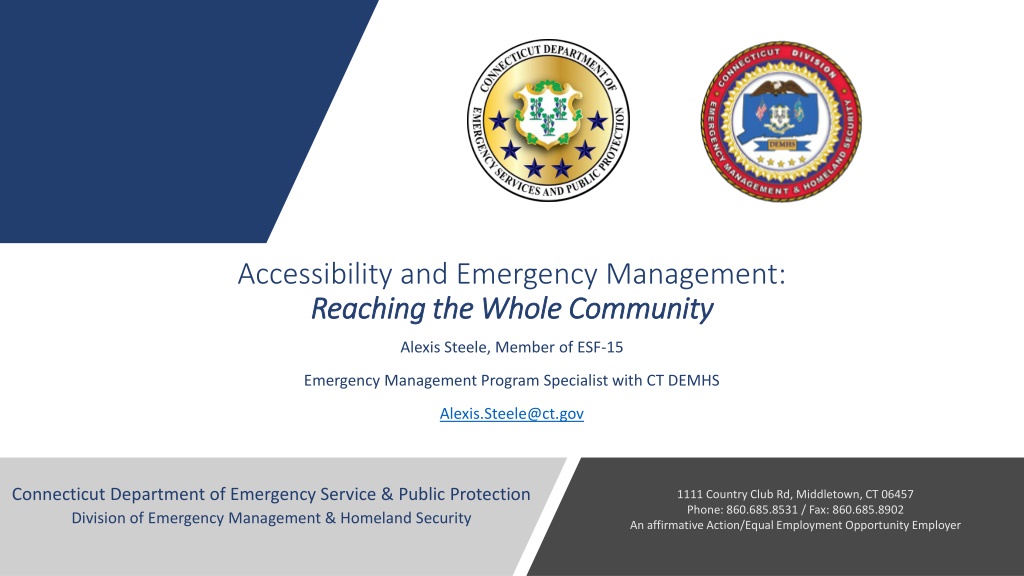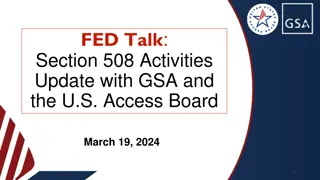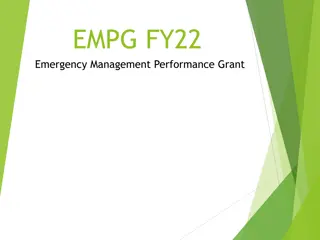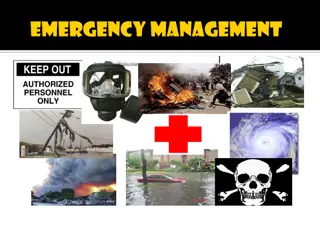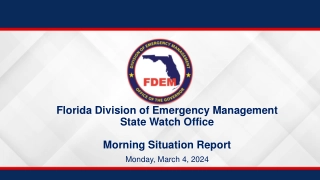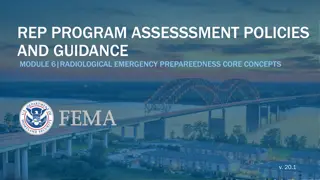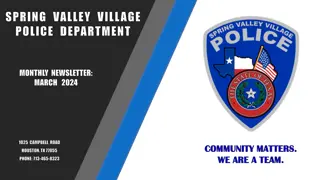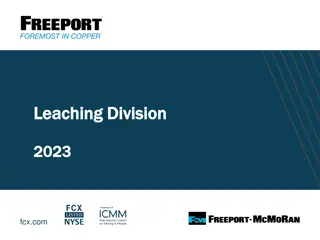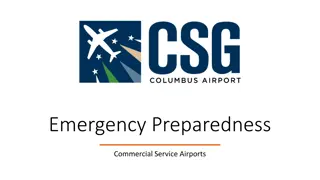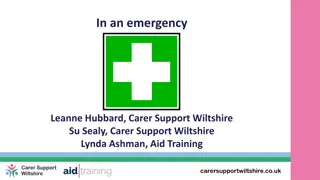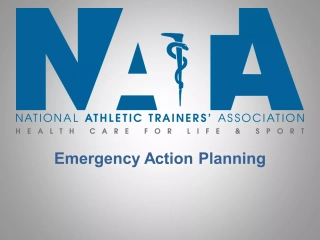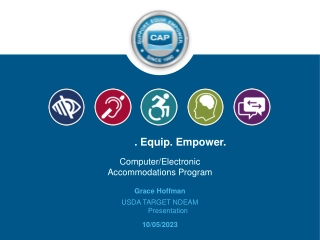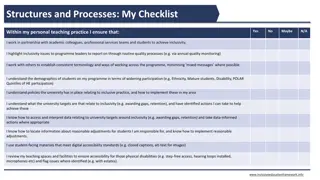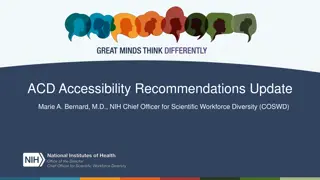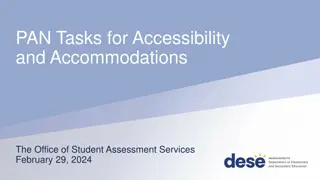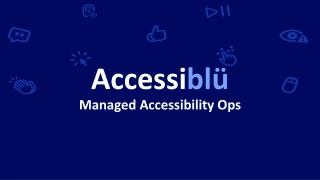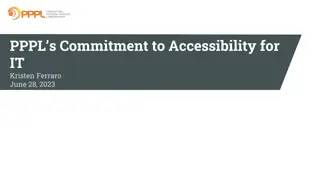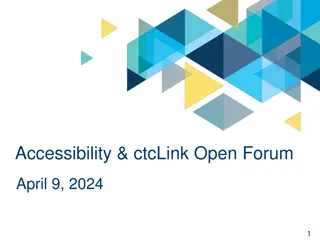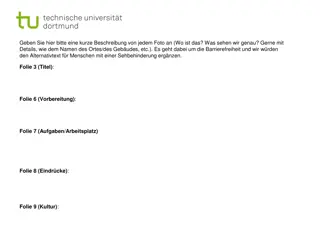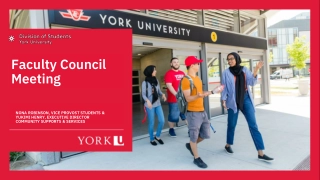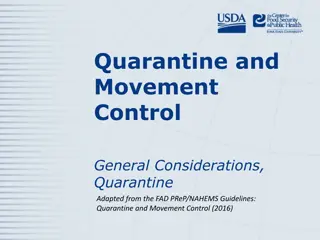Accessibility and Emergency Management:
Engage the whole community in emergency management by employing accessible communication strategies. Consider language diversity, plain language materials, and partnerships with ethnic media and faith-based groups to ensure crucial information reaches everyone effectively.
Download Presentation
Please find below an Image/Link to download the presentation.
The content on the website is provided AS IS for your information and personal use only. It may not be sold, licensed, or shared on other websites without obtaining consent from the author. Download presentation by click this link. If you encounter any issues during the download, it is possible that the publisher has removed the file from their server.
- Community preparedness
- Inclusive communication
- Emergency management
- Language diversity
- Ethnical partnerships
Presentation Transcript
Accessibility and Emergency Management: Reaching the Whole Community Reaching the Whole Community Alexis Steele, Member of ESF-15 Emergency Management Program Specialist with CT DEMHS Alexis.Steele@ct.gov Connecticut Department of Emergency Service & Public Protection Division of Emergency Management & Homeland Security 1111 Country Club Rd, Middletown, CT 06457 Phone: 860.685.8531 / Fax: 860.685.8902 An affirmative Action/Equal Employment Opportunity Employer
Public Information for all Plain language always reading level should not be more than 2nd grade. Nearly 1 in 5 adults in America cannot comprehend fourth-grade-level text Lots of pictographs/infographics supporting your message. Telling social stories. Considering making a silent video Your message will reach non- English speakers, people who need plain English, and those who cannot read small text. Source: Snob Monkey. https://snobmonkey.com/importance-of-infographics/
Which top languages are spoken in your community? Imperative to have all preparedness materials in the top three non- English languages spoken in your community. Flood awareness materials Designated radiological Emergency Planning Zones (EPZ) Evacuation routes How to build a go bag Red Cross Ready has free programs/advocates that train residents in different languages 22.1% of households in CT reported speaking a non-English language at home as their primary shared language. What are the top 5 in CT? Spanish Portuguese Chinese (Mandarin) Polish Italian
Languages spoken in Connecticut Source: DataUSA. https://datausa.io/profile/geo/connecticut/#demographics
Locations of Non-English-Speaking Populations in CT Source: ConnDOT. https://portal.ct.gov/- /media/DOT/documents/dc ontractcompliance/2020- maps/Statewide- Language.pdf
Start assessing the resources in your own community Ethnic media & Public Radio stations direct local info Trusted messengers every community has them, its up to you to seek them out and build a partnership. Utilizing the power of Faith-based communities Reach out BEFORE disaster strikes to establish a relationship. They may be willing to translate and disseminate important messaging during an emergency! Ensure that you are disseminating the appropriately translated materials to these locations. There may be worshiping spaces in your community you are not aware of.
Building your personal toolkit Resources all Emergency Managers should have in their toolkit: LanguageLine or adjacent translations services. Google Translate should never be used always inaccurate and offensive. Community health workers in your community often trusted messengers and multi-lingual. 211 has a list of translation services in your community. See what other connections United Way 211 has! Connecticut Council on Developmental Disabilities National organization, federally funded. Can provide support on these populations. State Independent Living Council Aging and Disabilities Community of Practice Connecticut
Disability is a spectrum Not JUST the aging population lifespan Not one-size fits all solution. Emergency response planning should be broad and person- centered. 1 in 4 adults have a disability. Disability doesn t discriminate. Anyone can age into a disability, have an accident, or may have an invisible disability.
Its the law! Americans with Disabilities Act of 1990 The Americans with Disabilities Act (ADA) prohibits discrimination against people with disabilities in employment, transportation, public accommodations, communications and access to state and local government' programs and services. Rehabilitation Act of 1973 Rehabilitation Act of 1973 prohibits discrimination based on disability in programs conducted by federal agencies, in programs receiving federal financial assistance, in federal employment and in the employment practices of federal contractors. Executive Order 13347 Individuals with Disabilities in Emergency Preparedness consider, in their emergency preparedness planning, the unique needs of agency employees with disabilities and individuals with disabilities whom the agency serves. Pets Evacuation and Transportation Standards Act of 2006 ensure that state and local emergency preparedness operational plans address the needs of individuals with household pets and service animals prior to, during, and following a major disaster or emergency.
Access and Functional Needs Are you unaware of the scope of needs in your community? This population comes with extensions of themselves that should NEVER leave their side. Communication based needs to consider: Reaching communication-based needs residents: People who have visual, audio, and/or cognitive needs related to the receipt of and response to information. People who require alternative formats of information Hold a Virtual Town Hall targeting this population and see who shows up. No one knows their needs better than them! Large and simple font on all materials Social media use as much as possible Training on how to use accessibility resources Grammarly, Microsoft Word Accessibility Checker Personal Care assistant Medications Service animals Assistive devices Whatever else they may need do not separate them from their devices.
Residents who may be on the spectrum Sensory overload will impact people on the spectrum. Scents, lights, and sounds can be triggers. To combat this, create sensory rooms/areas. Room dividers assist with creating these spaces. As always, keep all interaction Person centered treat all people with dignity! Don t ignore them because you feel unsure and ill- equipped to fit their needs.
Assistive Technology Screen readers - the communication device of sight- impaired folks Use headings to organize documents Screen reader will differentiate between structural elements in the document in a clearer manner. Using page numbers and tables of contents. Check your color palette for contrast. Always having an alt text or photo ID when you post photos on social media! Photo ID: Green frog that appears to be smiling, sitting on a green leaf. Source: Dartmouth Center for the Advancement of Learning. https://dcal.dartmouth.edu/resources/teaching- methods/creating-accessible-materials
Etiquette for ALL populations People-first language an individual with a disability as opposed to disabled person. Speak to people with empathy! We are all human beings who deserve respect, patience, and the ability to belong to the community. Consistent and ongoing communication with all populations is key, before, during and after a disaster The individual knows what they need. All you have to do is ask!
References ESF-15 Advocates that provided their knowledge for the creation of this presentation: Doris Maldonado maldonado.doris.a@gmail.com Rich Luby rich.luby@indnw.org My information: Alexis Steele Alexis.Steele@ct.gov
